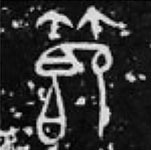I Ching, Yijing or Zhou Yi
"Oracle of the moon": © 2000 LiSe
 Yi Jing, Oracle of the Moon
Yi Jing, Oracle of the Moon

The image of hexagram 60
Jié, bamboo segment, restraint.
What does it mean, 'inner' and 'outer trigram' (popup)
Duì below Kăn: in a world of insecurities creatures need fixed structures and patterns. A very deep structure is pattern, even babies use rhythm. Interactions with this world, with others, with surroundings and activities need enough fixed structures or habits to deal with the large field of unknowns. Without noticing we search for patterns in everything out there, and we find them. There are differences between the discovery of one person and the next, but the basics are similar. The universe hands them to us, they are embedded in the entire creation.

Ideogram of the hexagram name: at the top 'bamboo', below a pot of food and a person who sits in front of it, connected with it, about to eat. This part limits something to 'what is', like namely, approach, reach, be near, assume, mean, at present, promptly. Bamboo and 'at present' or 'this'': bamboo segment, restraint, delimiting, festival. Bamboo segments were used as measuring cups for grain and rice, liquids, and in extension for the measure of time, like an hourglass.
節氣, "Jie qi", means 'solar terms/periods', or the day marking the beginning of a solar term.
The 'Great Image' says: Water at the top of the marsh: limits. The noble one delimits number and measure, and deliberates upon ethical conduct.
Hex.60 is the contrast of 56, where the measures are not familiar and the 'right' way has to be discovered and adapted to.
Hex.60 is 'inverse' to 59, dispersion, Xùn, Wind, above Kăn, Water, where structures disintegrate. Xùn outside 'does what it does', Kăn gives no inner or personal structure.
Hex.60 is about established measures, the fixed units of time, weight, volume and more.
A very rigid hexagram, but giving value to the most free means of expression. Living moment after moment instead of in an ongoing flow makes that possible. It lends meaning to each segment, acknowledging each time span as a unit with its own expression.
Restrictions need expiring dates, so every new cycle, every new moment, will have its own specific energy. Life becomes a composition. Not the notes but their rhythm and succession create a song.
Play your own music on your own flute. If your pitch is right, you will able to join in with others, and they with you.

